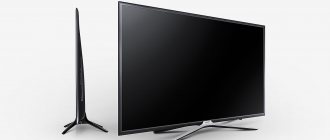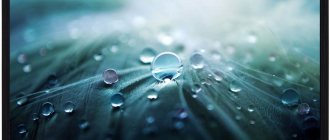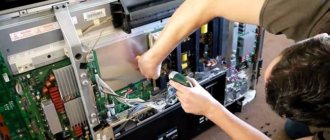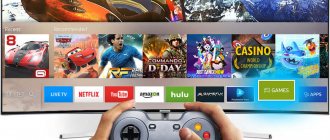Since 2008, Samsung has been using a single system when naming its televisions. It is this marking that we will analyze. Earlier models may be designated differently, but such devices are no longer available for sale.
From the TV markings you can find out the type of screen, year of manufacture, region for which the model is intended. By the series and subseries number you can also find out some technical characteristics, because the company announces in advance which series will contain which parameters.
This marking is located on the back wall of the device itself, on the packaging box and in the TV menu. Just note that the series number is not a “serial number”, but a number indicated in the model name, for example this: “Samsung UE40MU6100UXUA”.
Example of decoding markings
Let's look at models from different years and with different display matrices. The following describes all possible variations of marking.
2021 model with LED screen
Let's look at one example of Samsung TV labeling. From left to right:
- U – LED TV,
- E – region Europe,
- 75 – screen diagonal in inches,
- K – 2021 model,
- 9 is the ninth series, the numbers 0,0,0 won’t tell us anything without the help of specialists (the last two zeros talk about design),
- AB – indicates the type of tuner, which can be determined in the list below.
2021 model with QLED screen
Samsung is changing the labeling of QLED TVs in 2021:
- Now the series number can be indicated by three digits: the first is the series number, the second is a modification within the series, and the third is added for TVs with 8K resolution. If the series is indicated by only two numbers, then the resolution is 4K.
- Compared to the 2021 QLED labeling, there is no longer a designation for curved and flat screens. In 2021, all QLED models come with flat displays.
- After the letter designating the year of manufacture, there is now a designation for the presence of an HDMI 2.1 port. If it is A, then there is no port, but if B, there is a port.
- Next, as last year, is the letter designating the type of tuner. After it is the marking of the country of destination.
Let's decipher the designation of a Samsung TV, already for the Q model:
- Q – QLED TV
- E – region Europe
- 65 – screen diagonal in inches
- Q9 – 9 Series model
- 0 is the modification number and if there is one number, then the resolution is 4K, if there are two numbers, then the resolution is 8K
- R – year of manufacture 2019
- B – second generation, which means there is an HDMI 2.1 port and a new remote control for 2019 (A – first generation without an HDMI 2.1 port)
- U – tuner type
- XRU – destination country Russia
2021 model with QLED screen
- Q – QLED TV,
- E – region Europe,
- 65 – screen diagonal in inches,
- Q9 – 9-series model,
- F – flat screen (for curved ones the letter C),
- A – date of release and start of sales,
- M – the letter refers to design,
- U – tuner type,
- XRU – destination country Russia.
Screen view
The first letter indicates the screen manufacturing technology:
- U – illumination of the LCD matrix with LEDs (LED – Light-Emitting diode);
- Q – QLED, LCD matrix using quantum dots for backlighting, Quantum dot enhancement film (QDEF);
All modern Samsung TV models use liquid crystal matrices (LCD) as a display; the backlight of the matrix and the quality of the matrix itself differ. That's why there are regular U models and premium Q TVs.
Not released today:
- K – matrices of organic light-emitting diodes (OLED – Organic Light-Emitting Diode);
- P – plasma screen (PDP – Plasma Display Panel), discontinued in 2014;
- L – matrix illumination with fluorescent lamps (CCFL – Cold Cathode Fluorescent Lamp), not available since 2013;
- C - kinescope (CRT - Cathode Ray Tube - cathode ray tube), not produced today.
Screen types include shape; there are flat and curved displays. Already in 2021, only one series comes with a curved display, and before that there were more models with such a screen. Until 2018, the following letters were used in markings:
- F – flat screen (flat);
- C – curved screen (curved);
Continent
The second letter indicates the distribution area (for whom it is made):
- E – Europe;
- A – Asia, Africa, Australia;
- S – Iran;
- N – Korea, North and South America.
Screen size
Next in the model designation are two numbers, which indicate the screen diagonal size in inches (1 inch = 2.54 cm).
TV receivers are usually produced with screens from 32 inches to 65 inches, the most popular among users. There are also larger screens, but these are for larger rooms and most buyers do not choose them.
Popular types of matrices on today's TV
In order to find out what type of matrix is in your TV, it is necessary to mention the matrix models that dominate the market today.
The following main types of television matrices are presented on today's TV market:
- TN. TVs with TN matrix are the cheapest. This is the oldest technology, which can be easily identified by its very small viewing angle, low brightness and contrast;
- V.A. A matrix with this type is characterized by a larger viewing angle, excellent color gamut and image clarity;
- IPS. Matrices with this type have a large and convenient viewing angle and many modifications. This makes this type of matrix the most common and in demand among users. Identifying this type of matrix will not be difficult. Many manufacturers use only IPS matrix and its variations;
- Pls. The PLS type matrix is designed as an alternative to the more expensive IPS matrices. It is distinguished by high brightness, wide viewing angles, good color rendition and low price. Cons – low contrast and long delay in image output;
- S-PVA. Such matrices are also produced by Samsung. They are designed for higher level TVs than IPS TVs. These matrices are characterized by a deeper black level, smaller viewing angles than IPS and lower color rendering than IPS. S-PVA matrices can be found in Samsung TV models 7-8 series, Sony TVs 7-8 series, Phillips (7-8 series) and in models from other manufacturers;
- OLED. One of the best technologies to date, based on organic LEDs. Used by LG and Samsung. It’s easy to find out that this matrix is on your TV; more on that later. It is characterized by minimal thickness, low image output latency, unlimited contact, wide viewing angles, and the ability to use a flexible OLED display. The disadvantage is the different rates of pixel degradation and the very high price;
- Plasma TVs. These TVs are still available; the image in them is formed using a luminescent phosphor under the influence of UV rays. This TV does not require backlighting, since each cell is an independent light source. It has perfect black color, high dynamic resolution and great image depth. Disadvantages include low brightness, high price, heavy weight and high power consumption.
To determine which of the basic types of matrix is in the TV, we recommend using the methods listed below.
Year of issue
Next in the marking is a letter that indicates the year of manufacture. It was the letter designation of the year that Samsung chose.
- RU/R/Q*R – 2021
- NU/N/Q*N – 2021
- Q/MU/M – 2021
- KS/KU – 2021
- JS/JU – 2015
- HU/H – 2014
- F – 2013
- E – 2012
- D – 2011
- Since – 2010
- B – 2009
- A – 2008
Also in 2015-2016, additional letters were added to those that mean the year:
- S – TVs under the “SUHD” brand (produced in 2015 and 2016);
- U – ultra-high resolution 4K UHD screen.
All Q (QLED) and S (SUHD) models have 4K UHD resolution (3840x2160).
Previously, the following letter was also found (after the designation of the year): H - means a body of normal thickness;
If there are no other letters in the marking after the year designation letter, but the series immediately appears, then this means a regular LED HDTV TV with Full HD (1920x1080) or HD Ready (1366x768) resolution.
conclusions
The most important parameters that can be found from the labeling are the year of manufacture and the series number.
The main technical characteristics that distinguish one series from another are:
- Availability of ports (USB, HDMI, etc.);
- Image enhancement technologies (increasing frame rate, better color reproduction, etc.). For example: Wide Color Enhancer Plus, Clean View, Clear Motion Rate 100, 400, 600;
- Availability of a Wi-Fi module, LAN port for connecting to the Internet;
- Availability of a tuner, for example, for receiving digital television. It can be DVB-T2 or DVB-T;
- Screen resolution: HD Ready, Full HD, Ultra HD;
- Frame rate, the frequency of the matrix itself;
- Availability of 3D functions, Smart TV, voice or gesture control.
There is also surround sound, a browser, the number of cores in the processor, the thickness of the case, etc. Some functions will be important to you, while others can be neglected. Pay attention only to what is really important to you so as not to overpay for the purchase.
If earlier, when choosing a TV, special attention was paid to the picture tube, today the determining indicator of performance is the type of matrix. The consumer properties of modern TV equipment depend on it. Among the main parameters are:
- Life time.
- Image quality.
- Maintainability.
Therefore, when choosing a TV, you need to know the advantages and disadvantages of all existing matrix systems.
Ears on top of head
Packaging is the second face of the product. And it’s not just about the design: if it’s noticeable that the packaging has already been opened and the protective films have been removed, it’s time to refuse the purchase. Most likely this is a used TV or a display unit. Special attention should be paid to TVs with polished metal panels or chrome elements - they should not have scratches or other damage.
When receiving the package with the TV, you need to check:
- condition of the packaging (especially traces of moisture);
- complete set of accessories (remotes, cables, documentation);
- the presence of original protective films on the TV body and stand;
- no traces of dust (a clear sign that the product has been used).
Often the list of standard accessories is not limited to the remote control: for example, Samsung UE43M5513AUXRU is equipped with a corner adapter for the antenna, which allows you to hang the TV close to the wall. To avoid unnecessary costs and loss of time, it is better to immediately check whether everything is in place. If at this stage everything turns out to be in perfect order, and the case is shiny from protective films and seals, you can proceed to the main part - testing for functionality.
What types of matrices are used on modern TVs
Conventionally, all modern screens can be divided into two types:
- Liquid crystal displays (LCD) or in English – liqu > –>
But, in fact, the variety of matrices does not end there, because almost every manufacturer of monitors and television equipment is improving its products. And today, practically the only way to improve image quality is to make changes to the operation of the matrix. Therefore, every famous brand that produces displays and televisions has licensed matrices of its own design with an original name.
How to find out the model of Samsung TVs
The easiest and most proven way to clarify the markings is to use a sticker on the back panel, where all the information about the TV is located. You can also use the information on the original box or in the official accompanying documentation.
But what to do when these sources of information are not available? For example, when the box is missing and the label-sticker is damaged.
Firmware and software come to the rescue. The search instructions are as follows:
- go to the main settings menu;
- open the “About support” subsection;
- select the line “Contact Samsung”;
- in the dialog box we find the paragraph “Device information”;
- a list will be displayed where the required information is indicated in the “Model code” section;
- The necessary information is provided here.
Features and Benefits
Depending on the type of matrix, the image displayed on the screen has its own characteristics. Sometimes they are visible even to the naked eye, and in some cases, to notice the differences you need to pay attention to the display in different lighting or from different viewing angles. Depending on the type of matrix, screens may have an anti-reflective surface, and the effectiveness of their operation is determined by the arrangement, combination and principles of movement of the crystals. In the case of an LED matrix, the quality of the display determines the lifespan of the diodes. The color and overall lifespan of the screen depends on this.
The design of modern televisions is a case with a metal frame, in which connecting wires connected to the matrix are fixed. In addition, a light source is installed in LCD TVs as a backlight. Lighting used to come from mercury discharge lamps, but today most new displays use
LED backlight - LED. Therefore, many manufacturers claim that their TVs are created using LED technology. But this is far from the truth, because the matrix was and remains LCD, that is, LCD. To understand which TV design is better today, and to understand the disadvantages and advantages of displays, you need to know the features of various matrices.
Twisted Nematic (TN)
The first plasma TVs were introduced to world markets in the mid-90s by Fujitsu. The TN matrix, in which the crystals are twisted in a spiral, allowed her to do this. Depending on the tension, they may curl more or, on the contrary, straighten.
Thus, the angle of rotation of the crystals changes and, accordingly, the degree of transparency. Due to this, the color of each pixel changes. At the moment, such matrices are not produced, because back in 1996 a more advanced design appeared.
TN+Film
The main disadvantage of TN matrices was the small viewing angle. By using an additional diffuser layer, the so-called Film, the developers from Fujitsu managed to increase the viewing angle to 150 degrees. For the end of the last century, this was a real breakthrough in television technology. The main advantage of such matrices, in addition to the low price, is considered to be the high speed of response to signal changes.
How to find out the type of matrix in your TV
In order to understand what requirements must be placed on the quality of the image on the screen, it is necessary to determine what type it belongs to. Moreover, in the age of computer technology, this is extremely easy to do - enter the TV model into a search engine, and the World Wide Web will provide information on the technical characteristics in full.
If you don’t have the Internet at hand, then carefully study the data on the TV model; the types of matrices are also indicated there. Many manufacturers encrypt technical specification information in the serial numbers of their products. Therefore, if among the numbers you see a combination of letters - TN, TFT, IPS or other familiar abbreviations, then know that this is the name of the TV matrix.
You can also determine which playback technology is used by its characteristic features:
- To identify TN, check the contrast, contrast, and color gamut on the screen. If the quality indicators have decreased, then you have a TV with TN technology.
- Loss of color shades when looking at the right angle for a long time indicates MVA/PVA.
- A purple tint when looking at a screen with a black image at an angle indicates IPS.
When purchasing a TV, check all the information that the seller provides you.
IMPORTANT. Remember that the seller’s goal is to sell any product, and the buyer needs to buy the desired product at the lowest possible price.
The popular brand Samsung provides consumers with a wide range of products, which includes various household appliances and electronics. Samsung TV receivers are widely popular, they have excellent characteristics and allow you to plunge into the virtual world with all realism. The company's calling card is QLED TV devices, which are distinguished by high image quality, stunning detail and advanced functionality. The company tries to cover all niches, presenting budget, mid-range and premium models. In order to figure out which TV is what, let’s take a closer look at the labeling of Samsung TVs.











